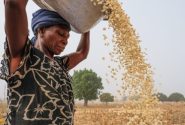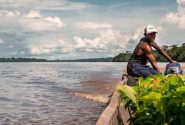
Almost half of tree species in the Brazilian State of Para valued by smallholders for serving nutritional and health needs are also felled for use as lumber, research shows. CIAT/Neil Palmer
LIMA, Peru (7 May, 2013) – Tropical fruits, leaves, oils and seeds from the Amazon rainforest provide food, medicine and income for millions of people, but their socio-economic importance for smallholders should not be overshadowed by the revenues reaped from the timber trade, scientists say.
Almost half of tree species in the heavily forested Brazilian State of Pará valued by smallholders for serving nutritional and health needs are also felled for use as lumber, research shows, leading to their designation by scientists as “conflict-of-use” species.
“On a broad scale, fragmentation of and loss of plant and animal species resulting from deforestation holds immeasurable consequences for Amazonian biodiversity and ecosystem value and function,” said Patricia Shanley, a scientist working with the Center for International Forestry Research (CIFOR), who will present a paper at the upcoming International Conference on Forests for Food Security and Nutrition hosted by the U.N. Food and Agriculture Organization (FAO).
“Declining availability of game, fruit and medicinal plants can result in nutritional deficiencies, illness and the loss of income from forest products,” she said.
About 60 percent of the terrain in the enormous state, which lies in the eastern Amazonian region of Brazil, is vulnerable to logging.
Wood products derived from logging in the area account for 47 percent of all timber produced in the Brazilian Amazon and in 2009 generated $1.1 billion in revenue, according to research cited in a paper co-written by Shanley.
The Brazilian Amazon, with a population of almost 25 million — including more than 300,000 indigenous people — represents almost 60 percent of Brazil’s territory, statistics show.
Overall, timber products in Brazil generated $1.7 billion of extractive production revenue in 2009, while other non-timber forest products generated $293 million, according to the Brazilian Institute of Geography and Statistics (IBGE).
However these statistics create an inaccurate impression, as they portray only handful of exported non-timber forest products, neglecting to capture the vast array of locally and regionally used and traded forest goods, the report said.
“Non-timber forest products are important to local communities because they provide a variety of products with nutritional subsistence and commercial value for local use or export,” said CIFOR scientist Manuel Guariguata, adding that the Amazon region is also under threat from agricultural expansion.
Conflict-of-use species
Shanley and other CIFOR scientists conducted a study of three products derived from conflict-of-use species in Pará prized for centuries for both their timber and non-timber uses: the seeds of the cumaru tree (Dipteryx odorata); latex from the bitter amapá amargoso (Parahancornia fasciculata); and the nutritious fruit of the uxi tree (Endopleura uchi).
Amapá latex, which is tapped from the tree, has medicinal value and is used to treat respiratory diseases, including tuberculosis. Uxi fruit is has high levels of vitamins C and B and is rich in such nutrients as potassium, magnesium and phosphorus. It is also valued because it attracts game animals, which are an important source of nutrition for people living in the region.
Cumaru is prized for its timber and its aromatic seeds are sold in the United States, Europe, India, China and Hong Kong for use in the perfume industry. In 2009, 97 tons of Cumaru seeds were exported for about $397 million, according to IBGE.
About 2,700 families in the study area gather cumaru seeds. The average price of the seeds more than doubled between 2008 and 2010, from $2 to $4.30 per kilogram.
If a cumaru tree is sold for wood, its value is about three times the value of a year’s harvest of seeds, according to Tadeu Melo of the Federal University of Acre, who worked with Shanley to study cumaru management. “However, in three years of harvesting seeds, a family can earn the equivalent of the sale price of the wood, and the tree will continue to be a source of seeds, For decades, families in this region have sustained their families through the sale of seeds.” Melo said.
Smallholders tend to manage production sustainably – finding a balance between conflicting uses.
“The key to deciding when and how to choose between selling wood or harvesting non-timber forest products is whether or not a market exists for the two products. If there’s only a market for wood, people will concentrate on timber management. If there’s only a seed market, they will sell seeds. If there is a market for both wood and non-timber products, it’s more advantageous in the long term to preserve the trees and sell the seeds.”
Smallholders in Pará manage the forest for both timber and non-timber products, generally taking advantage of seeds, fruit and latex produced by the trees during their most productive years and selling older, less-productive trees for wood.
In a separate study of andiroba (Carapa guianensis) in the western Brazilian state of Acre, researcher Christie Ann Klimas of the University of Florida found that approach of forest management was a sustainable strategy also used for managing the trees in seasonally flooded forests.
Smallholders monitored the productivity of individual trees and could identify those that were not as productive and would be more profitable if sold for timber.
Klimas noted that smallholders who manage their forests for multiple uses often have more detailed knowledge of the trees than professional foresters.
Researchers should draw on such knowledge to fill gaps in information about non-timber forest products, Shanley said.
“Smallholders in pockets of Amazonia are serving multiple and critical functions that have impacts beyond the local sphere,” she said.
“They add to scientific understanding by experimenting and generating knowledge about lesser-known species. They also supply local markets with foods of high nutritional and health value, protect essential ecosystem services, and conserve species that have multiple values for society.”
Managing multiple-use forests
Despite the importance of non-timber products for local livelihoods, official forest-management policies often overlook those species.
Paying more attention to them could lead to more accurate cost-benefit analysis and better land-use planning, Shanley said.
“Policies that promote secure land tenure and the collection and trade of non-timber products by smallholders can help support the conditions needed for multiple-use forest management,” she said.
Because most smallholders do not depend only on forests, but also engage in some farming and other income-producing activities, Guariguata said, policies should consider all of those livelihood strategies.
“It’s important to design and implement policies that benefit rural producers who practice a variety of economic activities,” he said.
“Timber, non-timber forest products, agriculture, fisheries and other productive activities are usually regulated in disharmony. If you actively promote a multiple-use vision that merges not only timber and non-timber products, but also other productive activities alongside the forest, a truly multifunctional landscape can be designed.”
This research is carried out as part of the CGIAR Research Program on Forests, Trees and Agroforestry.
We want you to share Forests News content, which is licensed under Creative Commons Attribution-NonCommercial-ShareAlike 4.0 International (CC BY-NC-SA 4.0). This means you are free to redistribute our material for non-commercial purposes. All we ask is that you give Forests News appropriate credit and link to the original Forests News content, indicate if changes were made, and distribute your contributions under the same Creative Commons license. You must notify Forests News if you repost, reprint or reuse our materials by contacting forestsnews@cifor-icraf.org.
Further reading
Combating malnutrition and infection with forests - Bronwen Powell
AUDIO Q+A: Do forest-dwelling children have more nutritious diets?
Forests foods should be used in fight against global malnutrition - scientist
Food consumption on three forest populatioons of the southern coastal area of Cameroon
CIFOR LIVE BLOG: FAO Forests for Food Security and Nutrition conference













